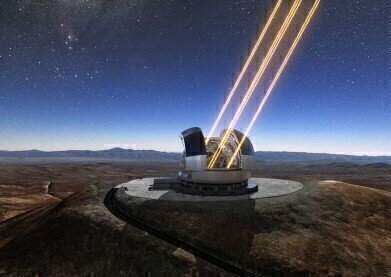-
 Artists impression of the complete ELT (Credit: ESO)
Artists impression of the complete ELT (Credit: ESO)
News & Views
Milestone for ELT Observed at Ceremony
Jun 25 2017
The laying of the first stone of the European Southern Observatory’s (ESO) Extremely Large Telescope (ELT) has taken place at ESO’s Paranal Observatory in northern Chile, close to the site of the future giant telescope. This milestone marks the beginning of the construction of the dome and main telescope structure of the world’s biggest optical telescope and ushers in a new era in astronomy.
In attendance was the President of the Republic of Chile, Michelle Bachelet Jeria, Tim de Zeeuw, Director General of ESO, Roberto Tamai, the ELT Programme Manager, and Andreas Kaufer, the Director of the La Silla Paranal Observatory.
Highlights of the ceremony included the sealing of a time capsule prepared by ESO. The contents include a poster of photographs of current ESO staff and a copy of the book describing the future scientific goals of the telescope.
In her speech, the President emphasised: “With the symbolic start of this construction work, we are building more than a telescope here: it is one of the greatest expressions of scientific and technological capabilities and of the extraordinary potential of international cooperation.”
Tim de Zeeuw from ESO said: “The ELT will produce discoveries that we simply cannot imagine today, and it will surely inspire numerous people around the world to think about science, technology and our place in the Universe. This will bring great benefit to the ESO Member States, to Chile, and to the rest of the world.”
With a main mirror 39 metres in diameter, the Extremely Large Telescope (ELT) will be the largest optical/infrared telescope in the world and will take telescope engineering into new territory. It will be housed in an enormous rotating dome 85 metres in diameter — comparable in area to a football pitch.
The ELT will be the biggest “eye” ever pointed towards the sky and may revolutionise our perception of the Universe. It will tackle a wide range of scientific challenges, including probing Earth-like exoplanets for signs of life, studying the nature of dark energy and dark matter, and observing the Universe’s early stages to explore our origins. It will also raise new questions we cannot conceive of today, as well as improving life here on Earth through new technology and engineering breakthroughs.
Digital Edition
Lab Asia 31.2 April 2024
April 2024
In This Edition Chromatography Articles - Approaches to troubleshooting an SPE method for the analysis of oligonucleotides (pt i) - High-precision liquid flow processes demand full fluidic c...
View all digital editions
Events
Apr 22 2024 Marrakech, Morroco
Making Pharmaceuticals Exhibition & Conference
Apr 23 2024 Coventry, UK
Apr 23 2024 Kintex, South Korea
Apr 23 2024 Seoul, South Korea
Apr 24 2024 Jakarta, Indonesia







.jpg)









